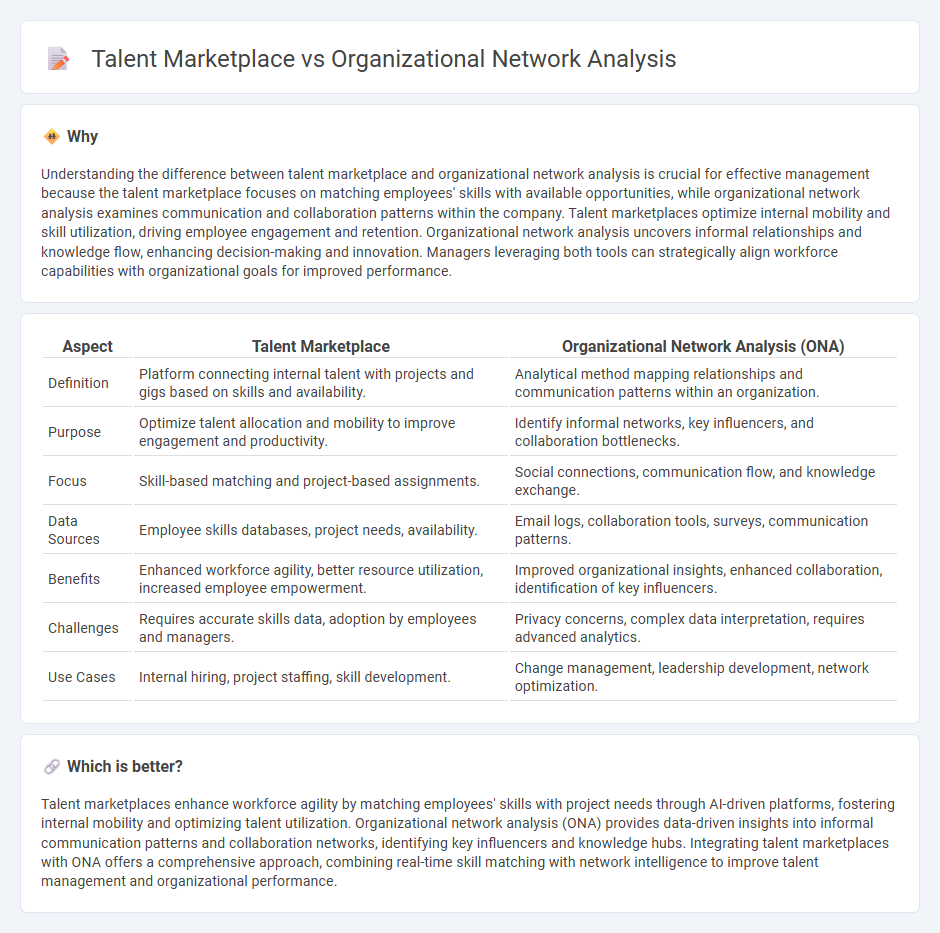
Talent marketplaces leverage dynamic platforms to match employees' skills with project needs, enhancing workforce agility and internal mobility. Organizational Network Analysis (ONA) maps informal relationships and communication flows to uncover collaboration patterns and identify key influencers within a company. Explore how integrating talent marketplaces with ONA can optimize talent management and drive organizational performance.
Why it is important
Understanding the difference between talent marketplace and organizational network analysis is crucial for effective management because the talent marketplace focuses on matching employees' skills with available opportunities, while organizational network analysis examines communication and collaboration patterns within the company. Talent marketplaces optimize internal mobility and skill utilization, driving employee engagement and retention. Organizational network analysis uncovers informal relationships and knowledge flow, enhancing decision-making and innovation. Managers leveraging both tools can strategically align workforce capabilities with organizational goals for improved performance.
Comparison Table
| Aspect | Talent Marketplace | Organizational Network Analysis (ONA) |
|---|---|---|
| Definition | Platform connecting internal talent with projects and gigs based on skills and availability. | Analytical method mapping relationships and communication patterns within an organization. |
| Purpose | Optimize talent allocation and mobility to improve engagement and productivity. | Identify informal networks, key influencers, and collaboration bottlenecks. |
| Focus | Skill-based matching and project-based assignments. | Social connections, communication flow, and knowledge exchange. |
| Data Sources | Employee skills databases, project needs, availability. | Email logs, collaboration tools, surveys, communication patterns. |
| Benefits | Enhanced workforce agility, better resource utilization, increased employee empowerment. | Improved organizational insights, enhanced collaboration, identification of key influencers. |
| Challenges | Requires accurate skills data, adoption by employees and managers. | Privacy concerns, complex data interpretation, requires advanced analytics. |
| Use Cases | Internal hiring, project staffing, skill development. | Change management, leadership development, network optimization. |
Which is better?
Talent marketplaces enhance workforce agility by matching employees' skills with project needs through AI-driven platforms, fostering internal mobility and optimizing talent utilization. Organizational network analysis (ONA) provides data-driven insights into informal communication patterns and collaboration networks, identifying key influencers and knowledge hubs. Integrating talent marketplaces with ONA offers a comprehensive approach, combining real-time skill matching with network intelligence to improve talent management and organizational performance.
Connection
Talent marketplace leverages real-time data to match employee skills with organizational needs, enhancing workforce agility and productivity. Organizational network analysis (ONA) maps communication patterns and collaboration flows within a company, revealing key influencers and skill clusters. Combining talent marketplace insights with ONA enables data-driven talent allocation, optimizes team dynamics, and drives strategic workforce planning.
Key Terms
**Organizational Network Analysis:**
Organizational Network Analysis (ONA) maps and measures relationships among employees to reveal informal communication patterns, collaboration intensity, and key influencers within a company. By leveraging data from emails, meetings, and project collaborations, ONA provides actionable insights to optimize team structures, improve knowledge flow, and enhance innovation. Discover how Organizational Network Analysis can transform your workforce productivity and decision-making process.
Social Connections
Organizational network analysis (ONA) leverages data on employee social connections to map informal networks, identify key influencers, and uncover collaboration patterns critical for enhancing organizational efficiency. Talent marketplaces emphasize dynamic talent mobility, connecting employees with projects and internal gigs based on skills and interests, while also considering social networks to foster better team cohesion. Discover how integrating ONA and talent marketplaces can transform workforce agility and innovation.
Information Flow
Organizational network analysis (ONA) maps and measures relationships and information flow between employees to optimize collaboration patterns, while talent marketplaces dynamically match internal talent with project opportunities based on skills and availability. ONA provides insights into informal communication channels and bottlenecks, enhancing knowledge sharing, whereas talent marketplaces facilitate efficient resource allocation and skill development within teams. Discover how leveraging both approaches can transform information flow and drive organizational agility.
 dowidth.com
dowidth.com